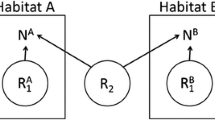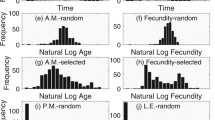Abstract
This article reviews the subject of resource choice by consumers. It is concerned with how such choice has been and should be represented in quantitative ecological models. This requires consideration of the dynamics of behavioral change and the fitness consequences of different resource intake rates. The topic is important because of the impact of choice on the functional response of the consumer to each of the resources it consumes. A variety of open questions related to choice are addressed. These include: the relationship between optimal diet choice and switching; the relationship between adaptive choice of two or resources and type-3 functional responses to a single resource; whether switching behavior requires choice and whether choice always results in switching behavior; why partial preferences are observed; whether choice between habitats is fundamentally different from choice within habitats; how between-individual variation in parameters related to resource use alters functional responses measured at the population level. The impacts of choice on stability are discussed briefly. The costs of increased resource use and the type of nutritional interactions between resources are particularly important determinants of adaptive resource choice, and are considered in some detail.


Similar content being viewed by others
References
Abrams PA (1982) Functional responses of optimal foragers. Am Nat 120:382–390
Abrams PA (1986) Character displacement and niche shift analyzed using consumer–resource models of competition. Theor Popul Biol 29:107–160
Abrams PA (1987) The functional responses of adaptive consumers of two resources. Theor Popul Biol 32:262–288
Abrams PA (1989) Decreasing functional responses as a result of adaptive consumer behaviour. Evol Ecol 3:95–114
Abrams PA (1990a) Mixed responses to resource densities and their implications for character displacement. Evol Ecol 4:93–102
Abrams PA (1990b) Adaptive responses of generalist herbivores to competition: convergence or divergence. Evol Ecol 4:103–114
Abrams PA (1992) Predators that benefit prey and prey that harm predators: unusual effects of interacting foraging adaptations. Am Nat 140:573–600
Abrams PA (1999) The adaptive dynamics of consumer choice. Am Nat 153:83–97
Abrams PA (2000) The impact of habitat selection on the heterogeneity of resources in varying environments. Ecology 81:2902–2913
Abrams PA (2003) Can adaptive evolution or behaviour lead to diversification of traits determining a trade-off between foraging gain and predation risk? Evol Ecol Res 5:653–670
Abrams PA (2006a) The prerequisites for and likelihood of generalist-specialist coexistence. Am Nat 167:329–342
Abrams PA (2006b) The effects of switching behaviour on the evolutionary diversification of generalist consumers. Am Nat 168:645–659
Abrams PA (2007) Habitat choice in predator-prey systems; spatial instability due to interacting adaptive movements. Am Nat 169:581–594
Abrams PA, Matsuda H (1993) Effects of adaptive predatory and anti-predator behavior in a two prey—one predator system. Evol Ecol 7:312–326
Abrams PA, Matsuda H (1996) Positive indirect effects between prey species that share predators. Ecology 77:610–616
Abrams PA, Matsuda H (1997) Prey evolution as a cause of predator–prey cycles. Evolution 51:1740–1748
Abrams PA, Matsuda H (2003) Population dynamical consequences of switching at low total prey densities. Popul Ecol 45:175–185
Abrams PA, Matsuda H (2004) Consequences of behavioral dynamics for the population dynamics of predator–prey systems with switching. Popul Ecol 46:13–25
Abrams PA, Schmitz OJ (1999) The effect of risk of mortality on the foraging behaviour of animals faced with time- and digestive-capacity constraints. Evol Ecol Res 1:285–301
Abrams PA, Cressman R, Krivan V (2007) The role of behavioral dynamics in determining the patch distributions of interacting species. Am Nat 169:505–518
Belovsky GE (1984) Herbivore optimal foraging: a comparative test of three models. Am Nat 124:97–115
Bergelson JM (1985) A mechanistic interpretation of prey selection by Anax junius larvae (Odonata: Aeschnidae). Ecology 66:1699–1705
Chesson PL (1985) Variable predators and switching behavior. Theor Popul Biol 26:1–26
de Mazancourt C, Dieckmann U (2004) Trade-off geometries and frequency-dependent selection. Am Nat 164:765–778
Dukas R (2008) Evolutionary biology of insect learning. Annu Rev Entomol 53:145–160
Dukas R, Kamil AC (2001) Limited attention: the constraint underlying search image. Behav Ecol 12:192–199
Fretwell SD, Lucas HL (1970) On territorial behavior and other factors influencing habitat distributions in birds. I. Theoretical development. Acta Biotheor 19:16–36
Fryxell JM, Lundberg P (1998) Individual behaviour and community dynamics. Chapman and Hall, London
Hanski I, Hansson L, Hentonnen H (1991) Specialist predators, generalist predators and the microtine rodent cycle. J Anim Ecol 60:353–367
Holling CS (1965) The functional response of predators to prey density and its role in mimicry and population regulation. Mem Ent Soc Canada 45:1–60
Holt RD (1977) Predation, apparent competition, and the structure of prey communities. Theor Popul Biol 12:197–229
Holt RD (1983) Optimal foraging and the form of the predator isocline. Am Nat 122:521–541
Kimbrell T, Holt RD (2004) On the interplay of predator switching and prey evasion in determining the stability of predator–prey dynamics. Israel J Zool 50:187–205
Kimbrell T, Holt RD (2005) Individual behaviour, space and predator evolution promote persistence in a two-patch system with predator switching. Evol Ecol Res 7:53–71
Kitting CL (1980) Herbivore–plant interactions of individual limpets maintaining a mixed diet of intertidal marine algae. Ecol Monogr 50:527–550
Krivan V (1997) Dynamic ideal-free distribution: effects of optimal patch choice on predator–prey dynamics. Am Nat 149:164–178
Krivan V, Eisner J (2006) The effect of Holling type II functional response on apparent competition. Theor Popul Biol 70:421–430
Lawlor LR, Maynard Smith J (1976) The coevolution and stability of competing species. Am Nat 110:79–99
Levins R (1968) Evolution in changing environments. Princeton University Press, Princeton
Ma BO, Abrams PA, Brassil CE (2003) Dynamic vs. instantaneous models of diet choice. Am Nat 162:668–684
MacArthur RH, Pianka ER (1966) On the optimal use of a patchy environment. Am Nat 100:603–609
Matsuda H (1985) Evolutionarily stable strategies for predator switching. J Theor Biol 115:351–366
Matsuda H, Kawasaki K, Shigesada N, Teramoto E, Ricciardi LM (1987) Evolutionary and ecological stability of prey–predator systems with predatory switching. Lect Notes Biomath 71:172–181
McCann KS, Hastings A, Huxel GR (1998) Weak trophic interactions and the balance of nature. Nature 395:794–798
McCann KS, Rasmussen JB, Umbanhowar J (2005) The dynamics of spatially coupled food webs. Ecol Lett 8:513–523
Murdoch WW (1969) Switching in general predators: experiments on prey specificity and stability of prey populations. Ecol Monogr 39:335–354
Murdoch WW, Oaten A (1975) Predation and population stability. Adv Ecol Res 9:1–131
Oaten A, Murdoch WW (1975a) Functional response and stability in predator–prey systems. Am Nat 109:289–298
Oaten A, Murdoch WW (1975b) Switching, functional response, and stability in predator–prey systems. Am Nat 109:299–318
Post DM, Connors ME, Goldberg DS (2000) Prey preference by a top predator and the stability of linked food chains. Ecology 81:8–14
Roughgarden J, Feldman M (1975) Species packing and predation pressure. Ecology 56:489–492
Rueffler C, Van Dooren TJM, Metz JAJ (2004) Adaptive walks on changing landscapes: Levins’ approach extended. Theor Pop Biol 65:165–178
Sarnelle O, Wilson AE (2008) Type III functional response in Daphnia. Ecology 89:1723–1732
Schwinning S, Rosenzweig ML (1990) Periodic oscillations in an ideal-free predator–prey distribution. Oikos 59:85–91
Siddon CE, Witman JD (2004) Behavioral indirect interactions: multiple predator effects and prey switching in the rocky subtidal. Ecology 85:2938–2945
Stephens DW, Krebs JR (1986) Foraging theory. Princeton University Press, Princeton
Sterner RW, Elser JJ (2002) Ecological stoichiometry: the biology of elements from molecules to the biosphere. Princeton University Press, Princeton
Tansky M (1978) Switching effect in prey–predator system. J Theor Biol 70:263–271
Teramoto E, Kawasaki K, Shigesada N (1979) Switching effect of predation on competitive prey species. J Theor Biol 79:303–315
Uchida S, Drossel B, Brose U (2007) The structure of food webs with adaptive behaviour. Ecol Model 206:263–276
van Baalen M, Krivan V, van Rijn PCJ, Sabelis MW (2001) Alternative food, switching predators, and the persistence of predator–prey systems. Am Nat 157:512–524
van Leeuwen E, Jansen VAA, Bright PW (2007) How population dynamics shape the functional response in a one-predator-two-prey system. Ecology 88:1571–1581
Yamauchi A, Yamamura N (2005) Effects of defense evolution and diet choice on population dynamics in a one-predator-two-prey system. Ecology 86:2513–2524
Acknowledgments
I thank the Natural Sciences and Engineering Research Council of Canada for financial support. I am also grateful to Professors Masakazu Shimada and Hiroyuki Matsuda for allowing me the opportunity to present this work at the 24th Meeting of the Japanese Population Ecology Society, and to two reviewers for their helpful comments on the first draft of this article.
Author information
Authors and Affiliations
Corresponding author
Rights and permissions
About this article
Cite this article
Abrams, P.A. Quantitative descriptions of resource choice in ecological models. Popul Ecol 52, 47–58 (2010). https://doi.org/10.1007/s10144-009-0175-z
Received:
Accepted:
Published:
Issue Date:
DOI: https://doi.org/10.1007/s10144-009-0175-z




